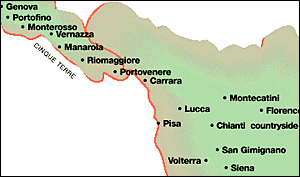
Nature and history have conspired to create the towns known as the Cinque Terre ("Five Lands", pronounced Chink'-wuh Tay'-ruh), tucked away in a series of little inlets at the very end of the levante (eastern) side of the Italy's Ligurian Riviera, to the south east of Genoa and the north west of La Spezia, and Pisa.
"Here we find untamed nature, completely virgin Mediterranean marquis. It is a breathtaking composition, a mosaic of a thousand shades, the old houses with their characteristic colors clinging to the rocks that drop sheer to the sea or perch on imposingly jagged hills, everything vying to touch the sky, lifting your gaze to the famous terraced slopes, reclaimed land contained by drystone walls."
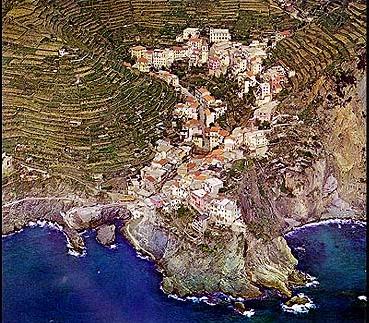
"This was work done long ago, at a time lost in history, by the local folk, a people well accustomed to contending with the difficulties of dizzying cliffs or precipitous slopes when getting about, and who, in order to survive, had to "steal" space."
"The terraces are works of peasant engineering, an operation which we can call "land architecture", and were used to create space for the cultivation of vines, olives and fruit. Such agriculture, able to support the livelihood of this population, together with the ancient art of fishing practiced in an uncontaminated sea, represents the major strength of this territory. A strength that, not without countless sacrifices, produces the famous white wine of the Cinque Terre; as well as the Sciacchetra (a dessert wine made from partially dried grapes); the olive oil of a particular fragrance and acidity; the famous anchovies and pesto (this region is the birthplace of pesto)."
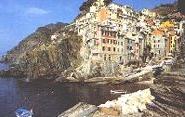 The above description was taken from a tour book purchased in the Cinque Terre when I was there in May. The above description was taken from a tour book purchased in the Cinque Terre when I was there in May.
We arrived at Riomaggiore (population 2152), the southernmost of the Cinque Terre towns. You enter Riomaggiore (Rio'-ma-jor'-ee), literally, from above. The narrow roadway snakes down the side of a mountain to deliver you to this fascinating town on the sea coast far below.
Don't expect to take your vehicle inside the town limits for automobiles are not permitted in the Cinque Terre. While Cinque Terre towns are now accessible by roadways, you must park at the edge of town (at a cost of approximately one Canadian dollar per hour, night and day - we found out), and walk to your accommodation. The towns are also linked by rail for those who travel without automobiles.
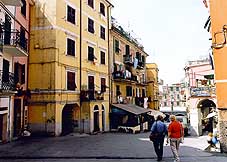 After parking our car, we walked down, and I mean "DOWN" the main road to our "room" and walked back up, and I mean "UP" to get our luggage once we had signed in. Riomaggiore is located totally on the side of a steep hill (Iím sure all residents have ball joints in their ankles for constantly walking either up or down). Luckily, a young lady in a small electric truck, used for local deliveries, was there to take our bags back DOWN the hill to our rented room. The vehicle used was quite dilapidated and, as I found out, the brakes didn't work. To stop the vehicle my driver would simply switch the electric power off and hope that we would come to a complete stop under the control of the dead motor. No one, including me, was killed so why worry about the small stuff? After parking our car, we walked down, and I mean "DOWN" the main road to our "room" and walked back up, and I mean "UP" to get our luggage once we had signed in. Riomaggiore is located totally on the side of a steep hill (Iím sure all residents have ball joints in their ankles for constantly walking either up or down). Luckily, a young lady in a small electric truck, used for local deliveries, was there to take our bags back DOWN the hill to our rented room. The vehicle used was quite dilapidated and, as I found out, the brakes didn't work. To stop the vehicle my driver would simply switch the electric power off and hope that we would come to a complete stop under the control of the dead motor. No one, including me, was killed so why worry about the small stuff?
The main road, which splits the town in two from north to south, is in turn divided by a flight of steps separating the seaside part of town, the fishing village from the hillside part where the farmers live. Riomaggiore is of recent origin compared to the other towns of the Cinque Terre, being founded around the end of the twelfth century.
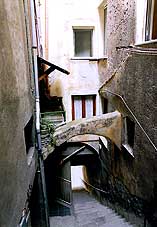 Our room was at the top of a row of buildings (up many, many steps), overlooking the Mediterranean. We had an outdoor patio (on the roof of someone else's "room"). Outside our window, across to the other side of the hill we could see fresh lemons growing. And we could hear the waves crashing on the jagged rocks below us throughout the night. Our room was at the top of a row of buildings (up many, many steps), overlooking the Mediterranean. We had an outdoor patio (on the roof of someone else's "room"). Outside our window, across to the other side of the hill we could see fresh lemons growing. And we could hear the waves crashing on the jagged rocks below us throughout the night.
We had a wonderful evening meal at one of the many outdoor "ristorantes"; serenaded by a tom cat, in heat, sitting on the canopy just above our heads. (And, in Italy, the cats really do say "meow-ah"......honest.)
I ordered the grilled shrimp, which were gathered from the sea earlier that day. My shrimp arrived sprawled in my plate, full bodied with beady little grilled eyeballs gawking up at me. My first instinct was to try to separate the tails from the bodies using my knife and fork. While I was successful in my attempt, it didn't come without an embarrassing moment. The shell was harder than expected. When I pressed down with my knife it made it's cut with a quick snap, causing the upper body of my shrimp to become airborne, landing on a lady's foot at the next table. Thankfully, she smiled at me (or was she laughing?).
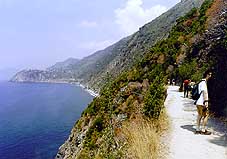 Up bright and early the next
morning I started on my hike. An easy, 20 minute walk on an even surface cut into the cliffs
(Via dell' Amore - Lover's Lane) along the sea coast, brought me to the second village, Up bright and early the next
morning I started on my hike. An easy, 20 minute walk on an even surface cut into the cliffs
(Via dell' Amore - Lover's Lane) along the sea coast, brought me to the second village,
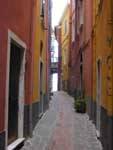 Manarola (Man-eh-roll'-a), a tiny and rugged tumble of buildings bunny-hopping down its ravine to the tiny harbour (population 739). The hike took me through the characteristic narrow alleys (carugi) between the stacks of buildings.
Manarola (Man-eh-roll'-a), a tiny and rugged tumble of buildings bunny-hopping down its ravine to the tiny harbour (population 739). The hike took me through the characteristic narrow alleys (carugi) between the stacks of buildings.
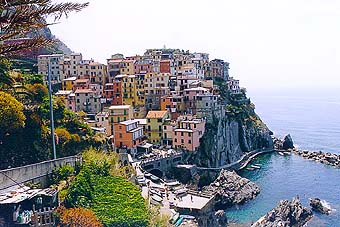 Like Riomaggiore, Manarola is relatively new on the scene, dating back to the twelfth century. Looking down over the valley, and up above, you can see an intense cultivation of vines. Manarola is the greatest producer of grapes for the wine of the Cinque Terre. Like Riomaggiore, Manarola is relatively new on the scene, dating back to the twelfth century. Looking down over the valley, and up above, you can see an intense cultivation of vines. Manarola is the greatest producer of grapes for the wine of the Cinque Terre.
The hike from Manarola to Corneiglia (Cor-ne'-le-ah) becomes more rugged and is a bit longer than stage one of the hike, taking about 45 minutes to complete. It's no longer a level walk. Instead you are on the cliff's narrowing pathways, above and below the grape vine terraces and, again, always along the sea coast.
Corneiglia (population 540) is the only one of the five towns perched high on the summit of a rocky headland overlooking the sea; the other towns being situated just above sea level. Corneiglia was settled prior to the year 1000. I arrived on outdoor market day. Vendors were assembled in the town "piazza" selling their fresh goods which included fish, meat, fruits, vegetables, cheese and the Italian version of Tupperware.
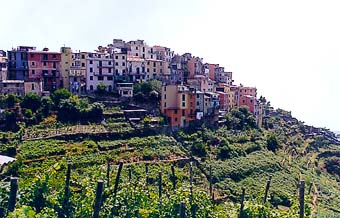 Here I had my first glimpse of the ingenious monorail system used in the Cinque Terre to transport the freshly picked grapes from the vines up, or down, the side of the mountain to the town center for processing. The rail looks similar to a rail fence. The transporting device consists of a small, one-seater, engine with several carts attached in series. It's far too steep to transport the grapes by hand so the "little engine that could" does the work for them. Here I had my first glimpse of the ingenious monorail system used in the Cinque Terre to transport the freshly picked grapes from the vines up, or down, the side of the mountain to the town center for processing. The rail looks similar to a rail fence. The transporting device consists of a small, one-seater, engine with several carts attached in series. It's far too steep to transport the grapes by hand so the "little engine that could" does the work for them.
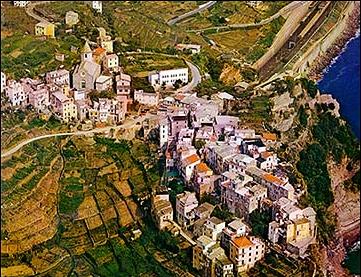 The hike from Corneiglia to Vernazza (Ver-nat'-cha) takes about 90 minutes and "the wildest and greenest of the coast - is most rewarding". The path continues to get narrower. Here I walked through my first olive grove and watched small lizards, that had been sunning themselves in the path, scamper for cover just ahead of my footsteps. Again, the grape vine terraces lined the cliffs above me to the sky and below me to the sea. The hike from Corneiglia to Vernazza (Ver-nat'-cha) takes about 90 minutes and "the wildest and greenest of the coast - is most rewarding". The path continues to get narrower. Here I walked through my first olive grove and watched small lizards, that had been sunning themselves in the path, scamper for cover just ahead of my footsteps. Again, the grape vine terraces lined the cliffs above me to the sky and below me to the sea.
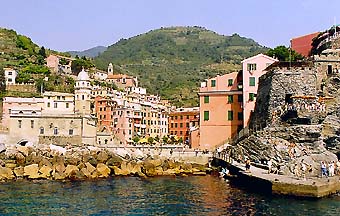 Vernazza (population 1,238) dates back beyond the eleventh century and, just ahead of Riomaggiore, is the most magical of the five towns. I stopped here for lunch and purchased what turned out to be my most memorable pizza ever. Mind you, obtaining it was no easy chore. Vernazza (population 1,238) dates back beyond the eleventh century and, just ahead of Riomaggiore, is the most magical of the five towns. I stopped here for lunch and purchased what turned out to be my most memorable pizza ever. Mind you, obtaining it was no easy chore.
I entered a small shop with the intent of purchasing meat, cheese and bread to make my own picnic lunch. I first tried to order in Italian, which was a lost cause. My second (Canadian) attempt delivered worse results. At the end of my third (pointing and grunting) attempt, the young lady behind the counter gave me the famous Italian "eeeh!" and walked away, leaving me stranded and hungry. (She actually did walk away from me, impatient and in disgust.)
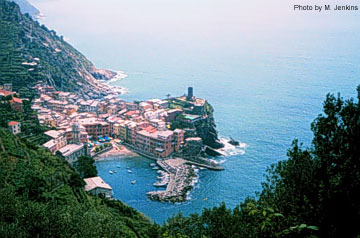 Next door, at the pizza shop, I was able to purchase a portion of the famous Italian Pizza Margurita (tomato sauce, water buffalo cheese and basil) with little difficulty. I also ordered a bottle of beer and was given a Heineken. When I asked if they had Italian beer, I received a replacement with a similar delivery of the Italian "eeeh!". Next door, at the pizza shop, I was able to purchase a portion of the famous Italian Pizza Margurita (tomato sauce, water buffalo cheese and basil) with little difficulty. I also ordered a bottle of beer and was given a Heineken. When I asked if they had Italian beer, I received a replacement with a similar delivery of the Italian "eeeh!".
But it was all worth it in the end. The pizza was marvelous. The beer tasted like cigar smoke, but what the heck, I was in Italy eating pizza. I was joined by a delightful elderly Austrian couple. We had a pleasant chat......until the lady choked on her pizza and coughed her lung up on my table.
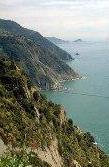 A scenic up and down hike brought me to Monterosso (Mon-ter-oh'-so) in another 90 minutes. This was the roughest section so far, but amazingly beautiful. By now the path was narrowed to single file in many places and it was a series of ups and downs all the way. On occasion, if one were to step to the outside of the path, the journey would have been straight down many hundred feet into the ocean. A scenic up and down hike brought me to Monterosso (Mon-ter-oh'-so) in another 90 minutes. This was the roughest section so far, but amazingly beautiful. By now the path was narrowed to single file in many places and it was a series of ups and downs all the way. On occasion, if one were to step to the outside of the path, the journey would have been straight down many hundred feet into the ocean.
During this section I came across small garden huts where the farmers would keep their implements and, perhaps, spend the night when necessary. There's no way to adequately describe the sights that I experienced.
By the way, although I undertook the hike by myself, I was never alone. While not crowded, the trail was well occupied with people from all over the world, including an intriguing number of hikers from Australia (I learned that Italy is a popular destination for Australians). I used my newly acquired "Buon giorno" as much as possible but it was lost on most occasions as I heard numerous languages coming back at me (but not one "How's she goiní?")
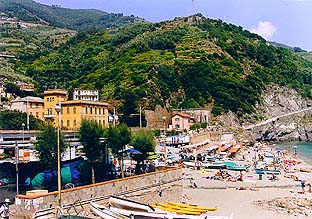 Monterosso (population 1840) dates back to year 1000 and, to me, is the least charming of all five towns as it is a resort with hotels, rentable beach umbrellas, and crowds. Nevertheless, it is still charming in it's own way. I didn't spend much time in Monterosso as I learned that my train back to Riomaggiore was supposed to leave almost immediately upon my arrival, "was supposed to" being the operative words. Monterosso (population 1840) dates back to year 1000 and, to me, is the least charming of all five towns as it is a resort with hotels, rentable beach umbrellas, and crowds. Nevertheless, it is still charming in it's own way. I didn't spend much time in Monterosso as I learned that my train back to Riomaggiore was supposed to leave almost immediately upon my arrival, "was supposed to" being the operative words.
The split second timing of neighboring countries to the north hasn't quite caught on yet in Italy. We waited, and waited, and waited. Then we were told that the train would be arriving on the "other" tracks. There were two sets of tracks in the middle with a platform on either side. We were told that we didn't have sufficient time to get to the other platform by going through the tunnel under the tracks, and that we would have to jump three feet down, on the tracks; scamper across the tracks; then hoist ourselves up on the other platform (also three feet above the tracks). We were told to do this quickly as the train was coming.
Do you have a picture of this in your mind? I could visualize the newspapers back home, reporting my death, among the others, and all of my friends wondering what in hell I was doing on the tracks in the first place.
We all made it unharmed. The train arrived and I fought with the locals to get on and find a seat, as per standard practice in Italy. Then the train sat there for about twenty minutes while the conductor, wearing a long, greasy ponytail, got off and smoked several cigarettes outside my window.
The trip back to Riomaggiore was about 15 minutes. Most of it was underground, inside the cliffs that make up the Cinque Terre. The hiking distance was somewhere in the range of 18 kilometres. My hiking time was about 5 hours, allowing for sufficient dawdling time in the three middle villages, which is a completely necessary part of the hike.
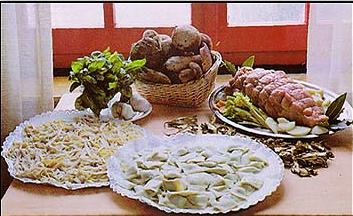 Back in Riomaggiore, after a nice long rest, we had another splendid outdoor evening meal complete with Cinque Terre wine, without any embarrassing experiences. We moved up the street to a different location. Our friend, the tom cat, followed us and began to serenade his beloved, this time from under our table. The ristorante staff didn't seem to mind, so who were we to complain? Back in Riomaggiore, after a nice long rest, we had another splendid outdoor evening meal complete with Cinque Terre wine, without any embarrassing experiences. We moved up the street to a different location. Our friend, the tom cat, followed us and began to serenade his beloved, this time from under our table. The ristorante staff didn't seem to mind, so who were we to complain?
I had a beef and pasta concoction. It's hard to say if it was really as tasty as it seemed, or if it was the atmosphere of just being there. Whatever, it was wonderful.
Another restful night was spent, listening to the Mediterranean pounding the shoreline below our room as I reflected on my wonderful hike, surely one of the best I've ever been on to date. The weather cooperated splendidly - sunny and warm all the way.
And this was just a portion of our vacation in Italy. Prior to our time in the Cinque Terre we visited Orvieto; Siena; several Tuscan hill towns; Pisa and the marble quarries of Carrara. Yet to be experienced were visits to Courmayeur, and a cable car ride to the base of Mount Blanc; a close up view of the Matterhorn from the Italian side (known in Italy as Cervino); Stradaveri's grave site in Cremona; Russi; the fabulous art (and carved, etched and painted penises) of Florence; the forests of Assisi where Saint Francis was said to have spoken with the birds and animals; and Rome where we were to see the Capitoline Hill, the Colosseum, the Roman Forum, the Palatine Hill, the Circus Maximus (or, "de track of Ben Hur" according to our guide), the Trivi Fountain, the Spanish Steps and Vatican city, including visits to the Sistine Chapel, Saint Peters Basilica and an appearance by JP II in the flesh.
It was a fabulous vacation. At first I was a bit shocked by the rude treatment we received from the Italians. But, upon noticing that they were also rude to each other, I simply accepted it for what it was - a different, and intriguing way of life.
However, there is one improvement that I'd like to recommend to the Italian government. Perhaps if they would require all elderly women to wear slacks, rather than black skirts, while riding bicycles and/or sitting on their front steps, it would go a long way toward improving the scenery, if you can picture what Iím getting at. |